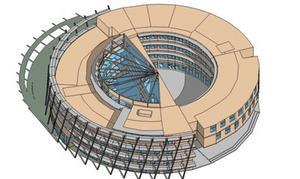The new HQ building for the Irish Office of Public Works, designed with low energy in mind, kicks off this month’s IT product focus
IES Consultancy helped achieve a 50% reduction in energy consumption for Ireland’s Office of Public Works’ (OPW) HQ building using its Virtual Environment software.
As the body responsible for the development of a series of new central government buildings, OPW knew that when creating its own HQ for 275 staff in Trim, County Meath, it needed a flagship, ‘green’ building it could hold up as a low-energy benchmark.
OPW brought in IES on a consultancy basis at the early stages of the design process. IES’s Virtual Environment software can compare and contrast how different design choices affect the performance of a wide range of elements that impact on sustainability and comfort in the building, including thermal, airflow and lighting.
The main goal was to achieve a significant reduction in energy consumption. The structured simulation strategy allowed IES to use appropriate tools (external wind and thermal studies) at the early to mid design stages to help determine the optimum design solution for the building, while also ensuring comfort. Ten key design features that significantly enhanced the thermal performance of the building were identified:
- Triple-opening façade
- Night cooling
- Exposed mass
- Better glazing-to-façade ratio
- Inclusion of an atrium
- Enhanced shading system
- Solar control glazing system
- Intelligent placement of airflow obstructions like cellular offices
- Identification of localised cooling requirements
- Atrium independent solution created for the minister’s office.
During winter, underfloor heating in the atrium and a high-level extract system generate a positive flow, promoting uniform temperature distribution and minimising the influence of any draughts on occupants near the atrium.
The building also succeeds at using natural daylight. Overcast conditions produce natural lighting levels with a daylight factor between 1 and 3 and a good distribution across the working plane. Sunny conditions produce natural daylighting levels of 450-500 lux.
The early stage analysis identified that the initial thermal configuration failed to maintain comfort conditions in line with current CIBSE best practice guidelines.
By using the model, the concept design was modified, ensuring that inside temperatures of 25ºC were only exceeded for 41 hours on average, compared to the initial plan’s 416 hours.
Finally, a holistic analysis of energy performance was undertaken, looking at thermal, lighting and airflow performance. The simulation calculated that the annual energy consumption for this building will be 185 kWh/m2/year, representing an annual energy saving of 59.4% over a type 4 ECON 19 building and 48.5% over an equivalent notational building. Associated reductions in CO2 emissions have also been estimated.
Downloads
Actual Energy Consumption
Other, Size 0 kbNotional Energy Consumption
Other, Size 0 kb
Source
Building Sustainable Design























No comments yet